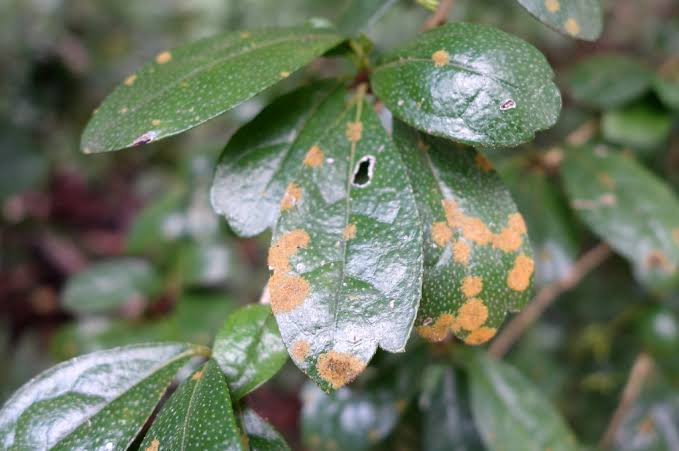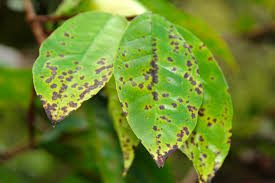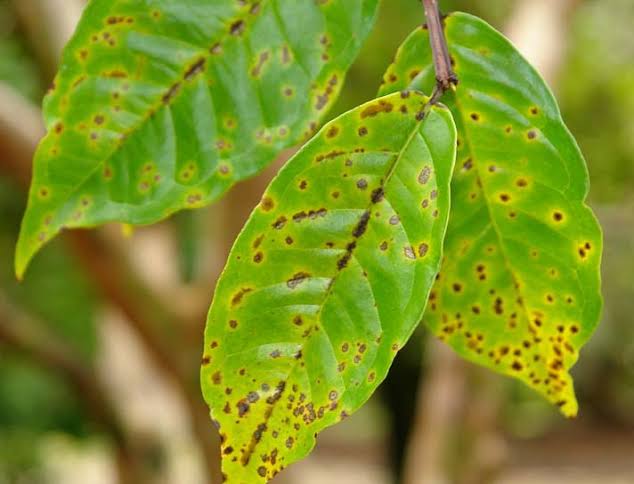Algal leaf spot, scientifically known as Cephaleuros virescens, is a common plant disease caused by a microscopic alga. This tiny organism, belonging to the genus Cephaleuros, often goes unnoticed until it manifests as distinctive leaf spots on various plants. Algal leaf spot affects a wide range of hosts, including trees, shrubs, and ornamental plants.
The alga responsible for this condition thrives in warm and humid climates, creating an optimal environment for its growth and spread. Cephaleuros virescens typically begins its life cycle as microscopic spores that can be dispersed by wind, rain, or human activities. Once these spores come into contact with susceptible plant surfaces, they germinate and establish themselves, initiating the development of algal leaf spot.
One of the primary signs of algal leaf spot is the appearance of small, circular to irregularly shaped lesions on the leaves of infected plants. These lesions usually have a green to reddish-brown coloration and may be surrounded by a darker border. As the disease progresses, the spots can merge, leading to more extensive areas of discoloration and potential damage to the plant’s foliage.
The impact of algal leaf spot on plants goes beyond mere aesthetic concerns. In severe cases, the alga can interfere with the normal photosynthetic processes of the host plant, affecting its overall health and vigor. This can result in reduced growth, defoliation, and, in extreme cases, increased susceptibility to other diseases or environmental stressors.
Preventing and managing algal leaf spot involves a combination of cultural and chemical control measures. Adequate plant spacing, proper pruning, and promoting good air circulation around plants can help minimize the conditions favoring algal growth. Additionally, applying fungicides or algaecides, especially during periods of high humidity, can be effective in controlling the spread of the disease.
However, algal leaf spot, caused by the alga Cephaleuros virescens, poses a notable threat to various plant species. Recognizing the symptoms and understanding the conditions conducive to its development are crucial steps in managing and preventing the impact of this common plant disease. Implementing appropriate control measures can contribute to maintaining the health and vitality of affected plants, ensuring a thriving and aesthetically pleasing landscape.
Read Also: How to Farm and Care for North Pacific Hake Fish (Merluccius productus)
Plants Affected by Algal Leaf Spot (Cephaleuros virescens)

Algal leaf spot is known to affect a diverse range of plants, spanning various species and types. Trees, shrubs, and ornamental plants can fall victim to this microscopic alga, Cephaleuros virescens. The versatility of the host plants makes algal leaf spot a concern for gardeners, horticulturists, and arborists alike.
Common trees susceptible to algal leaf spot include but are not limited to:
1. Citrus Trees: Lemon, orange, and other citrus varieties can be affected, potentially impacting fruit quality.
2. Deciduous Trees: Various deciduous trees, such as maples, oaks, and elms, may exhibit symptoms of algal leaf spot.
3. Azaleas and Rhododendrons: These popular flowering shrubs can develop characteristic leaf spots when infected.
4. Camellias: Known for their vibrant blooms, camellias may experience leaf discoloration due to algal leaf spot.
5. Hibiscus: This tropical and subtropical flowering plant can show signs of algal leaf spot on its leaves.
6. Boxwood: Commonly used for hedging and landscaping, boxwood plants may suffer from aesthetic issues caused by this disease.
The broad spectrum of susceptible plants emphasizes the importance of vigilance and proactive management strategies to prevent and mitigate the impact of algal leaf spot. Recognizing the signs and symptoms early on allows for timely intervention, contributing to the overall health and vitality of the affected greenery.
Damages Caused by Algal Leaf Spot

Algal leaf spot, caused by Cephaleuros virescens, can result in various damages to affected plants. While the severity of the impact may vary depending on factors such as the host plant’s susceptibility and environmental conditions, the consequences of algal leaf spot can be significant. Here are some common damages associated with this plant disease:
1. Reduced Photosynthetic Efficiency: The algal spots on leaves can disrupt the normal photosynthetic process. As a result, the affected plants may experience a decrease in their ability to produce and store energy, which is crucial for growth and overall health.
2. Defoliation: In severe cases, algal leaf spot can lead to the premature shedding of leaves. This defoliation weakens the plant and diminishes its aesthetic appeal. Additionally, the loss of foliage can impact the plant’s ability to carry out essential functions.
3. Stunted Growth: The interference with photosynthesis and nutrient absorption can hinder the growth of the affected plants. Stunted growth is a common consequence, and affected plants may struggle to reach their full potential in terms of size and vigor.
4. Increased Vulnerability to Other Stressors: Algal leaf spot weakens the overall health of plants, making them more susceptible to other environmental stressors and diseases. This can create a domino effect, where the initial damage caused by the alga paves the way for additional challenges.
5. Aesthetic Decline: Beyond the physiological impacts, algal leaf spot can mar the visual appeal of plants. The characteristic circular to irregularly shaped lesions with a green to reddish-brown coloration can make affected leaves unattractive, impacting the ornamental value of plants in landscaping and gardens.
To mitigate these damages, it is crucial to implement effective control measures, including cultural practices and, if necessary, the application of fungicides or algaecides. Timely intervention can help manage algal leaf spot and promote the recovery and resilience of affected plants.
Read Also: How to Farm and Care for Atlantic Horse Mackerel Fish (Trachurus trachurus)
Control and Preventive Measures

Controlling and preventing algal leaf spot involves a combination of cultural practices and, when necessary, the application of chemical measures. Here are some effective strategies to manage and minimize the impact of Cephaleuros virescens:
1. Pruning and Proper Plant Spacing: Regular pruning helps improve air circulation around plants, reducing the humidity that favors algal growth. Adequate plant spacing prevents overcrowding, minimizing the conditions conducive to the spread of algal leaf spot.
2. Watering Practices: Avoid overhead watering, as wet foliage provides a favorable environment for the alga to thrive. Water plants at the base to keep the leaves dry and reduce the risk of disease development.
3. Remove and Dispose of Infected Leaves: Promptly remove and dispose of leaves showing signs of algal leaf spot to prevent the further spread of spores.
4. Apply Fungicides or Algaecides: In cases where algal leaf spot is persistent or severe, the application of fungicides or algaecides may be warranted. Consult with a horticulturist or local extension service for appropriate recommendations. Timing is crucial when using chemical controls, and applications should align with the alga’s life cycle.
5. Maintain Plant Health: Ensure that plants receive proper nutrients through fertilization, as healthy plants are better equipped to resist and recover from diseases. Address any other stressors, such as poor soil conditions or insect infestations, that could weaken plant health.
6. Monitor Environmental Conditions: Regularly monitor weather conditions, especially humidity levels. Algal leaf spot thrives in humid environments, so heightened awareness during such periods is essential.
7. Consider Resistant Plant Varieties: When planning new plantings, consider selecting varieties that are known to be resistant to algal leaf spot.
8. Mulching: Apply a layer of organic mulch around plants to help maintain soil moisture and regulate temperature, creating less favorable conditions for algal growth.
Implementing a holistic approach that combines these measures can significantly reduce the occurrence and impact of algal leaf spot. Regular observation and timely intervention are key components of successful management strategies.
Frequently Asked Questions (FAQs) About Algal Leaf Spot (Cephaleuros virescens)
1. Q: What is algal leaf spot, and how does it affect plants?
A: Algal leaf spot is a plant disease caused by the microscopic alga Cephaleuros virescens. It manifests as circular to irregular lesions on leaves, impacting the plant’s health by disrupting photosynthesis and potentially leading to defoliation.
2. Q: Which plants are commonly affected by algal leaf spot?
A: Algal leaf spot can affect a wide range of plants, including trees (such as citrus and deciduous trees), shrubs (like azaleas and camellias), and ornamental plants (such as hibiscus and boxwood).
3. Q: What are the signs and symptoms of algal leaf spot?
A: Signs include small lesions on leaves with a green to reddish-brown coloration, often surrounded by a darker border. As the disease progresses, these spots can merge, leading to widespread discoloration.
4. Q: How can I prevent algal leaf spot in my plants?
A: Prevention involves practices like proper pruning, maintaining good air circulation, avoiding overhead watering, and promptly removing infected leaves. Additionally, considering resistant plant varieties and monitoring environmental conditions can be helpful.
5. Q: Are there chemical treatments for algal leaf spot, and when should they be applied?
A: In severe cases, fungicides or algaecides may be used. Consult with a horticulturist for appropriate recommendations, and timing of application should align with the alga’s life cycle.
6. Q: Can algal leaf spot affect plant growth and overall health?
A: Yes, algal leaf spot can reduce photosynthetic efficiency, cause defoliation, stunt plant growth, and increase vulnerability to other stressors. Managing the disease is crucial to maintaining the overall health and vigor of affected plants.
7. Q: Is algal leaf spot contagious between plants?
A: While it doesn’t spread directly between plants, the microscopic spores of Cephaleuros virescens can be dispersed by wind, rain, or human activities, potentially leading to new infections.
8. Q: How can I tell if my plant has algal leaf spot, and what should I do if I suspect an infection?
A: Look for characteristic lesions on the leaves. If you suspect an infection, promptly remove and dispose of infected leaves, implement preventive measures, and seek advice from local gardening experts or extension services.
Read Also: Potato Farming Guide – 7 Tips to Grow Sacks Full of Potatoes

